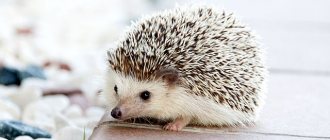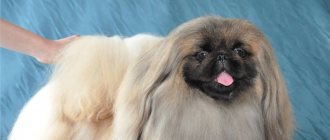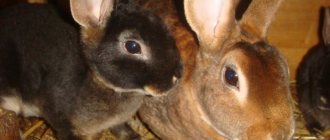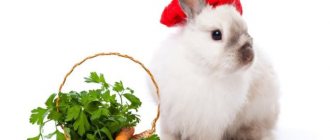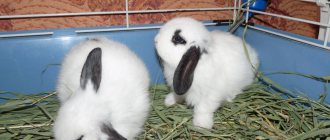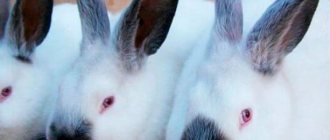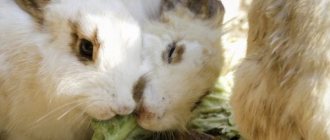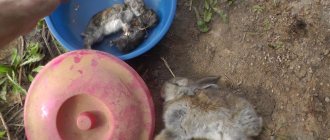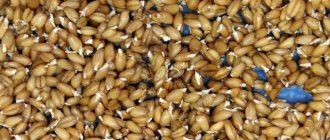Expert opinion
Dobryshev Sergey Anatolievich
Professional rabbit breeder and hare breeder with 30 years of experience
These funny, cute little animals are often found at pet shows. Decorative rabbits with drooping ears are also called lop-eared rams. Breeders felt that the wide forehead and small head corresponded to this nickname.
In fact, these cute animals look more like plush toys than the animals we all know. Pets enjoy living in an apartment and get along well with children. A fold-eared pet does not need much for normal development - only a balanced diet and good care.
History of breeding
It is quite easy to distinguish the ram rabbit from other brothers, because its characteristic feature is its long ears hanging down. The first mentions of furry animals with ears drooping along their heads can be found in the works of Charles Darwin.
It should be noted that drooping ears are the result of a natural mutation: they fit tightly to the animal’s muzzle and thereby make the small rodent look like a lamb. Fold rabbits, or “giants” as they are also called, are the largest among all representatives of their decorative relatives.
For many years, breeders around the world have been working on developing new varieties of this breed of furry animals. For example, Dutch specialists managed to create miniature ram rabbits. The Dutch breed was developed relatively recently by the scientist Adrian de Kock.
His first attempt to cross a Netherland Dwarf with a French ram in 1949 failed because the offspring were not viable.
However, as a result of painstaking work, in 1964, 15 years after the start of selection, the Dutch breed of miniature lop-eared sheep rabbits was officially registered. Soon, Dutch lambs found their way to European countries, and 10 years later they “reached” America.
Breed varieties
The dwarf rabbit Ram received its unusual name due to its external similarity with these stubborn animals. The animal has a massive, but small head with a wide forehead, reminiscent of a lamb.
There are several types of decorative lop-eared rabbits:
- Dutch (Dutch) - the Dutch lop-eared rabbit has the smallest weight among all representatives of the breed, which does not exceed 1-1.5 kg. They have gained popularity due to their soft, plush coat and sweet, friendly nature.
- The French is the largest among the Lop-eared dwarf rams; the weight of the animal can reach 6-8 kg. They are distinguished by a calm, balanced character and various color options.
- German – a characteristic feature of this breed is a “crown” of wool of a different color, located between the ears of the animal. Rabbits of this breed have a calm, peaceful character.
- English is one of the rarest breeds of rabbits. Dwarf ram. A characteristic feature is heavy, massive drooping ears, the length of which can reach 40-60 cm. Needs regular communication with the owner, otherwise it becomes cowardly and wild.
Lop-eared rabbit Dwarf ram has different colors - white, chinchilla, red, fawn, black.
The most popular, common and miniature rabbits of the lop-eared sheep breed are the Dutch ones. An adorable, small and fluffy animal with a flattened face and floppy ears, it makes an excellent pet for families with children and an ideal show animal.
Appearance
Today, the breed of lop-eared rabbits has a number of varieties:
- French;
- Dutch;
- German;
- English;
- corduroy, or plush;
- Meissen;
- dwarf;
- giant;
- nappy;
- white.
| Appearance | Description |
| Color | Solid color, depending on the breed can be ash, beige, white, red, light brown, black |
| Torso | Small, fairly short, but stocky, no more than 30 cm long |
| Head | Medium in size, with a slightly flattened, square-shaped muzzle |
| Eyes | Large, expressive |
| Ears | Long, hanging down, 28–70 cm long |
| Mustache | Quite long and thick |
| Neck | Short, practically absent |
| Paws | Short, quite strong |
| Tail | Short, close to the body |
| Wool | Thick, dense, very soft, silky, pleasant to the touch |
Did you know? Long ears hanging down are a kind of calling card of this variety of rabbits. However, in newborn rabbits, the ears stick up for a long time, and only 5–6 weeks after birth they begin to gradually fall, thus forming the main unique feature of the breed.
Feeding
Proper feeding ensures the animal maintains good condition and prevents the occurrence of many diseases. Animals must have food and water at all times, always clean and fresh. Animals should be given water not with boiled water, but with settled raw water. If lop-eared rabbits consume boiled water, they will begin to suffer from a lack of minerals.
Fold-eared food should always be fresh and clean
It is useful to give sprouted grains as a treat to rabbits. The main diet consists of:
- Hay;
- Fresh seasonal grass - it is fashionable to feed it instead of hay all summer long;
- Vegetables;
- Fruits;
- Dried fruits - as a treat in winter to replenish vitamins in the body;
- Compound feed for dwarf rabbits.
The animals also need branches of fruit trees, which are inserted through the bars of the cage. They will not only keep the rabbit occupied for a while, but will also allow him to clean the incisors of tartar and grind them down, which is necessary to maintain health.
Fresh grass is beneficial for lop ears
All forage that is collected in nature, such as seasonal grass and branches, should be taken only from places located at least 2 km from the highway. You also cannot collect greens near industrial zones.
Characteristics and description of the breed
Lop-eared sheep rabbits are highly valued not only for their decorative qualities, but also for their high productivity, valuable high-quality fur, and tender, delicious meat.
Animals can be classified according to the following parameters:
| Breed characteristics | Description |
| Direction | Meat, meat and skin, fur, decorative |
| Wool | Normal-haired, short-haired |
| Female weight | 1.5–2 kg |
| Male weight | 2.5–3 kg, but some breeds can reach a weight of 10 kg |
| Constitution | Strong, quite muscular, stocky, with a wide chest and strong paws, but at the same time quite fragile and tender |
| Sexual maturity | Rabbits reach sexual maturity 5–7 months after birth: females - after 5, males - after 7. It is not recommended to allow animals to mate before this time |
| Fruitfulness | Average degree of fertility: 4–8 rabbits can be expected in one litter |
| Tendency to various diseases | They are susceptible to various infectious and parasitic diseases, especially viral hemorrhagic disease, dermatitis, myxomatosis, and pasteurellosis. Often have hearing pathologies due to large accumulations of wax in the ears |
| How long do they live? | On average 5–8 years, in some cases they can live 10–12 years |
Important! The most sensitive part of the body of lop-eared rams are the ears: they are very receptive to various kinds of touches. Twitching, tugging and even the slightest touch cause severe discomfort and even pain in the animal.
Rabbit vaccination
The most dangerous diseases are hemorrhage and myxomatosis. How long decorative rabbits and lop-eared sheep live in a house depends on their health. To protect the animal from diseases, they are vaccinated with vaccines. They are performed when the animal reaches 45 days, and the weight must be at least 500 grams.
Expert opinion
Dobryshev Sergey Anatolievich
Professional rabbit breeder and hare breeder with 30 years of experience
10 days before vaccination, the rabbit is given anti-worm medications.
If the owner of a furry animal does not plan to breed rabbits, he will be spayed or neutered. The operation is performed when the animal is 4-6 months old. Fold-eared pets live only 5 years, rarely 8-10 years.
You can tell that a rabbit is sick by the following symptoms:
- the fur has become dull and is no longer shiny and silky;
- poor appetite;
- the animal is no longer active, does not want to play;
- the temperature rises above 39.6°C.
Such symptoms are a reason to urgently contact a veterinarian. If the rabbit has a fever, then relieve its condition with a cold compress, which is applied to the tummy and ears.
To prevent diseases, protect your pet from overheating, hypothermia and drafts. Do not install the cage in a place where direct rays of the sun fall.
Do not give food to the rabbit from your table. It is forbidden to give milk, chocolate, meat. The stomach is not designed to digest such food, and digestive problems arise.
Productive qualities
As a rule, sheep rabbits are bred for decorative purposes. However, these animals have excellent productive qualities. One of the main advantages of the breed is the precocity of rabbits and rapid weight gain.
At the age of 5–7 months, when rabbits reach sexual maturity, they already weigh from 1.5 to 3 kg, with the greatest growth dynamics observed up to 3 months. The final height and weight of animals are formed at the age of 6–8 months.
Of course, the rate of body weight gain is considered one of the most important productive characteristics for farmers breeding sheep and rabbits for the purpose of selling meat products. With increased and high-quality nutrition, some individuals are able to gain weight up to 10 kg.
Important! Rams
are quite voracious rabbits, so if keeping these animals has a decorative purpose, then it is very important for breeders to monitor their diet.
Obesity can provoke health-threatening diseases, in particular, damage to the liver, heart, and disruption of the digestive tract. In addition to high meat performance, lamb rabbits can boast of high-quality and valuable fur. The animal's skin is soft, dense, the wool is thick and silky, with a beautiful uniform color.
Temperament
Fold rabbits are distinguished by their excellent character, calm temperament, and easy-going disposition. They are very sociable, sociable, playful, easily get used to their owner and adapt to new conditions.
Their playful nature especially appeals to children. However, it is not recommended to have an animal if there are small children in the house, since they can cause pain to the rabbit, and he, in turn, is able to respond with aggression or even bite. In other cases, these animals are friendly and quickly make contact.
Many people wonder whether these rabbits live alone or prefer company. Animals can live well alone, although they do not mind sharing housing with other relatives. Usually, lambs quickly find a common language with each other and, when they get to know each other well, form close bonds and continue to be friends until the end of their lives.
You will be interested to know which breeds of rabbits are classified as meat-skin rabbits - butterfly, gray and white giant, chinchilla, and which breeds are classified as meat - Strokach, Flanders, Californian.
Character of lop-eared rabbits
The favorites of women and children have a calm and friendly character. At first, the animals show caution and timidity, then they become so accustomed to people and the environment that they play and frolic with pleasure. Decorative rabbits are curious and quickly begin to explore new habitats.
Animals are often attached to their owner, such as dogs.
Advantages and disadvantages of content
Ram rabbits get along well with both adults and children, due to which they quickly win everyone's love. However, their maintenance is accompanied by a number of rules and requirements that must be met to maintain good pet health and the desired productive qualities.
- Keeping lop-eared animals has the following advantages:
- good adaptation of animals to various environmental conditions;
- calm, balanced and peaceful character;
- relative ease of care;
- unpretentiousness in nutrition;
- rapid growth and weight gain.
- Meanwhile, keeping a sheep rabbit at home has a number of difficulties:
- high susceptibility of animals to various infectious and viral diseases;
- low immunity of rams;
- regular mandatory hygienic procedures for caring for your pet, in particular, combing the fur, removing wax from the ears, trimming claws, etc.;
- daily games with a pet: a rabbit needs games and communication every day, so if he is deprived of care for a long time, he can become offended and begin to show aggression in order to attract attention.
In addition, it is very important to provide the animal with a complete diet, balanced in minerals and vitamins. Otherwise, he will begin to get seriously ill, which can even lead to death.
Rules for choosing good individuals
Fold rabbits are quite exotic pets, and to purchase a purebred rabbit, you should pay attention to some characteristic features.
Signs of purebredness
Signs of purebred ram rabbits are:
- a rounded “mutton” head with a rather wide forehead and a square-shaped muzzle;
- an almost invisible neck, shallow-lying eyes, a perfectly defined nose;
- firmly set ears, hanging down in the form of a horseshoe, 24 cm long;
- wide and strong chest;
- flat, wide back;
- strong short legs;
- tail tightly fitting to the body;
- thick, shiny, soft, dense coat distributed over the entire body;
- uniform coloring, typical of normal-haired breeds.
Find out if it is profitable to raise rabbits.
Signs of marriage
Signs of marriage in this breed include the following:
- weakly defined small head, clearly visible neck, deep-set eyes;
- vertical position of at least one ear, short ear length (less than 24 cm);
- narrow, shallow chest;
- uneven back with a hump;
- fairly long, curved, hairless paws;
- sparse, matted fur with bald spots on the body;
- atypical color, with spots, “stains” or patterns on the body.
Origin
Charles Darwin mentioned lop-eared rabbits in his treatises. He noted that if healthy rabbits with erect ears gave birth to animals with drooping ears, this anomaly persists in subsequent generations.
The English lop-eared rabbit Ram is the oldest representative of this species . They were first introduced in 1890, and in 1908 the breed was officially registered with the International Hermelin Breeders Club. Rabbits got their name from the unusual shape of their muzzle, reminiscent of a ram. At the same time, breeding work on animals was continued and in the mid-twentieth century, the fold-eared dwarf breed of Ram rabbits was bred. It quickly spread throughout the world and today has ceased to be a rarity in Russia. Also read about the Loman Brown chicken breed here.
The first mention of rabbits came from England
Features of keeping rabbits at home
Despite the fact that sheep rabbits adapt well to the external environment, when keeping them, you need to follow a few simple principles of nutrition and maintenance.
Home arrangement
Regardless of whether an animal has the ability to move freely indoors or not, it needs a home.
Housing arrangement is based on the following requirements:
- Size. Ideally, the larger the animal's cage, the better. However, the minimum dimensions of the structure are 80x80x50 cm per individual.
- Temperature. Fold lambs are quite thermophilic, so they need a warm microclimate. The optimal temperature is considered to be 20–22 °C. In winter, animals are kept in well-heated rooms, since hypothermia of individuals can lead to their death.
- Litter. The best bedding material for the cage is considered to be crushed, dried wood shavings or newspaper paper without printed inscriptions. It is recommended to change the litter daily, otherwise dampness may occur.
- Ventilation. The rabbit's home should be well ventilated, but at the same time, be away from drafts or direct sunlight. The humidity in the room should average 60–80%.
- Tray. A prerequisite for arranging a cage is the installation of a special tray where the animal will go for its natural needs. The tray must be installed in one of the corners and firmly attached to the wall. As a rule, lambs can defecate while eating food, so the food feeder can be immediately mounted above the tray.
For drinking, special ready-made drinking bowls that are attached to the bars of the cage are perfect for rabbits.
Such structures provide the animal with constant access to water. It is recommended to choose feeders from heavy, ceramic material so that the animal cannot knock them over. Important! It is strictly forbidden to keep your pet in a cage all day long. You need to regularly give him walks, play with him, and give him the opportunity to run.
Features of feeding
Fold rabbits lead a relatively sedentary lifestyle, are often prone to laziness, and have a low metabolism, which is why they are prone to obesity. To prevent overeating, you should strictly monitor the animal's diet.
The basis of the sheep's menu is: hay, which should always be present in the cage, and special feed made from a mixture of various grains. Hay contains fiber in large quantities, which has a beneficial effect on the functioning of the digestive system, improves and accelerates metabolic processes.
In addition, it is recommended to include in the lop-eared menu:
- green food: meadow grass, plantain, yarrow, nettle, dandelion;
- fresh vegetables: carrots, potatoes, broccoli, radish;
- fruits: bananas, apples, pears;
- grain mixtures: oats, wheat.
You should not feed your pet the following foods:
- beets, beans, cauliflower or white cabbage, tomatoes or potato tops;
- any dairy products (however, if the baby rabbit is not more than 2 months old, in rare cases it can be given milk);
- meat and fish;
- sweets;
- crackers or chips;
- bread and flour products;
- food from a person's table.
Important! Until 6 months of age, rabbits should not be fed fresh herbs, vegetables or fruits, since the baby’s digestive system is not yet able to fully absorb fiber.
Twice a day, lambs need to be offered special fortified supplements - granules for rodents, which contain 16-18% protein, as well as all the necessary vitamins and minerals. Feed pets 2-3 times a day, preferably at the same period of time.
There must always be clean, fresh water in the drinking bowl, which the rodent will drink as needed.
Care and hygiene
Increased attention should be paid to pet hygiene and care. Rabbit ears require special care. To clean earwax from ears, you can use ordinary cotton swabs, which very carefully and accurately remove exudate.
Once every 2-3 weeks it is necessary to trim the claws, and for this you should purchase special tongs - nail clippers. It must be remembered that excessively large claws can cause deformation of the joints of the limbs, which is very dangerous for the health of the rodent.
The lop-eared pet has thick, dense hair of varying lengths, so it should be combed regularly and foreign objects removed. In rare cases, it is allowed to bathe and wash the rodent. To remove dirt, it is recommended to wipe contaminated areas of the body with a damp cloth.
It is equally important to keep your rabbit's home clean. Every day you need to change the bedding material, wash the feeders and drinking bowls. It is recommended to clean the tray at least 2 times a day - morning and evening. Complete disinfection of the cage must be carried out once every 1.5–2 months.
When deciding to purchase a fold-eared sheep, you need to be prepared for the fact that caring for it will take quite a lot of time.
After all, the animal must be provided with:
- daily walk for 1.5–3 hours;
- care of ears, coat and claws;
- everyday games;
- a complete, balanced diet.
Unfortunately, these rabbits are quite susceptible to various kinds of diseases, therefore, starting from the age of 45 days and reaching a weight of 0.5 kg, it is recommended to vaccinate the animal. The vaccine allows you to protect your pet from such serious illnesses as hemorrhagic disease, myxomatosis, and pasteurellosis.
Important! It is especially important to vaccinate animals that often leave their homes and attend various exhibitions and competitions.
For a larger number of infections, it is sufficient to vaccinate once every 12 months. Revaccination is carried out 3 months after the first injection. Next, vaccinations are given according to a specially developed vaccination schedule.
How to tame a pet?
Fold sheep are very cute, funny and playful creatures that should be trained gradually, starting from a very young age.
Babies are tamed as follows:
- they approach the cage with the rabbit quietly, calmly, without sudden movements, while addressing it tenderly and affectionately;
- the cage doors are left open so that the ram has the opportunity to independently leave its home, overcoming fear;
- if the pet shows aggression, then it is gently pressed to the floor with your palm;
- To encourage the animal, they always treat it with various delicacies;
- Every day they calmly and affectionately talk to the animal and offer food from their hands.
To properly keep rabbits, it will also be useful for you to learn how to correctly determine the sex of a rabbit, how to train a rabbit to a litter tray, and what to feed rabbits in winter.
Lambs love to spend time sitting on the owner’s hands or knees, but they have a negative attitude towards various types of “squeezing”, and can even bite painfully. Rodents get along well with cats, dogs, turtles, and parrots. Also, if the owner shows persistence and perseverance, they can learn to respond to a nickname.
Fold-eared animals' favorite pastimes include a variety of games:
- jumping from any kind of heights;
- chasing balls, small objects that jump and roll;
- digging holes and tunnels;
- running through tunnels and various obstacles.
It is necessary to remember that an angry rabbit can tear everything that comes into hand, or rather in the teeth, objects, jump, gallop, tear off wallpaper or damage the upholstery of furniture.
Therefore, his games should be carried out under the watchful supervision of the owner. Important! During the “play hour”, you should hide all things valuable to a person, since a playful animal can ruin them.
Disease Prevention
As mentioned above, lop-eared sheep rabbits, if hygiene and proper nutrition are not observed, are quite often exposed to various ailments. They especially suffer from: lesions of the ears, VGB, myxomatosis, dermatitis, disorders of the digestive system.
The risk group includes individuals who often walk outside, go to exhibitions and competitions, and come into contact with other animals.
Of course, the best prevention of infectious and viral diseases is vaccination, which significantly reduces the risk of developing the disease and reduces the likelihood of death to almost zero.
In addition, the simplest measures to prevent diseases are considered to be the banal maintenance of comfortable living conditions for the pet, a nutritious, fortified diet, a sufficient amount of fluid and the absence of stressful situations.
Particular attention should be paid if the lamb:
- refuses food and water;
- behaves depressed, sluggish, shows apathy towards others;
- begins to shed rapidly;
- doesn't react to anything.
Such symptoms may indicate the onset of the disease. In this case, the rodent should be taken to a veterinarian immediately.
Care and maintenance
Caring for and maintaining a Lop-eared sheep rabbit involves properly organizing a cage for the animal, a place to play, regular hygiene procedures and a balanced diet.
The cage with the animal must be placed in a sufficiently warm, well-lit and ventilated room. This should not be a walk-through room or a place where there are a lot of people. Animals also need to be hidden from drafts and bright, direct sunlight.
In the room where the rabbit hutch is located, you need to hide all electrical wires and make sure that the pet has a sufficient number of toys. In their absence, during play, a decorative rabbit can tear off wallpaper from the walls, tear or gnaw furniture upholstery, and tear things accidentally left behind.
IMPORTANT! Small animals love to run after balls, jump along tunnels and hills, chew paper, dig holes and catch small objects. Therefore, be sure to take care of your pet's toys. An excellent option would be special toy houses, labyrinths, and slides sold in zoological stores.
Cell selection
Caring for a lop-eared rabbit is very simple. The pet can live in a cage measuring 50x70 cm, with a small house, tray, drinking bowl and feeder inside. In nature, the animal lives in burrows and loves to hide in secret corners.
What to look for when choosing a cage:
- It is important that the cage has a small house where the animal can sleep during the daytime.
- A drinking bowl, feeder and tray are installed in the cage. It is best to choose durable and reliable ceramic products.
- The drinking bowl and feeder for active and playful animals can be mounted on the wall.
- You can buy a litter box for rabbits at a specialized pet store, or you can use a regular cat litter box.
- The lop-eared ram independently chooses a place for the toilet and will only go there. Therefore, first of all, you need to let the animal into the cage, give it the opportunity to choose a place and place a tray in it.
- Rabbits of the Lop-eared sheep breed are very clean, so the tray must be cleaned daily.
Furry animals need daily activity. But since free walks around the house can lead to damage to furniture or wiring, it is best to equip a special place for the rabbit, fenced with a mesh. After the walk, it can be removed and hidden.
Hygienic care
Before caring for an animal's fur, you need to consider that this pet, unlike cats and dogs, does not require bathing. To care for the fur of a decorative rabbit, it is enough to comb it 1-2 times a week. During the molting period, the animal needs to be combed every day. 2-3 times a week you need to wash your pet’s eyes and clean his ears.
Every 10-12 weeks, your pet's nails should be trimmed using a nail clipper, which can be purchased at pet stores. Trimming claws is an essential part of caring for a rabbit, otherwise he will begin to wear them down on his own, digging holes and tunnels in the cage.
IMPORTANT! You can only bathe your rabbit in extreme heat and when dirty. After bathing, the animal should be wrapped in a warm terry towel or blanket and held in your arms, away from drafts.
Rabbit breeding
Breeding fold sheep is not accompanied by any particular difficulties, either physical or financial. The breed is unpretentious, but during mating you should still pay attention to some aspects.
Animals are fully ready for mating by 8 months. If the female and male begin to behave restlessly, they are placed in a separate cage and left for 1 week. The owner has the opportunity to find out about the results of mating only 2 weeks after he thoroughly palpates the female’s belly. Pregnancy proceeds quickly - 28–31 days.
Did you know? The record holder for the longest ears is a decorative rabbit nicknamed Nipper's Geronimo. The length of his ears from the tip of the head to the bottom is a whopping 79 cm.
Principles of selection for reproduction
For mating, completely healthy individuals who have reached sexual maturity are selected. For dwarf species, it is recommended to choose a female and a male weighing no more than 1.5–2 kg, respectively, since exceeding these figures makes the fertilization process almost impossible.
This type of rodent is less fertile than other species. In one litter, a female can bring from 4 to 8 cubs.
For the homogeneity of the tribe, it is recommended to cross individuals of the same variety, identical in color, ear shape, coat quality, approximate size and weight.
It is prohibited to cross rams with other breeds, since the offspring will, firstly, be quite weak, secondly, have genetic abnormalities, and thirdly, will lose a unique feature - lop ears.
Care and feeding of young animals
In the first month of life, newborn rabbits are kept with their mother, who feeds them milk. Next, the young animals are “transferred” to a separate cage; optimally, a group of 3 individuals is formed in each dwelling. When the babies are 3 months old, the males are separated separately.
Find out how to feed baby rabbits without a mother rabbit.
There is an opinion that up to six months, small lambs should eat as much as they want. However, this breed is very prone to obesity, so the amount of food eaten should be strictly controlled. The basis of their diet is chopped hay and special food intended for rabbits.
Rabbits do not require any special care from humans, since females have a well-developed maternal instinct and take excellent care of their offspring.
Rabbit feeding lop-eared ram
For a rabbit, a properly formulated diet is of great importance. Babies under 6 months should not receive fresh greens, as well as raw vegetables and fruits. When the lop ear grows up, these products can be added to the food, but only in small quantities. The basis of the diet of a decorative rabbit is grain mixtures and hay, which can also be purchased in a specialized store.
When creating a menu, it is necessary to take into account that hay is the main component of the animal’s diet, so it should always be available. In addition, you definitely need to buy a mineral stone and fix it on the bars of the cage.


